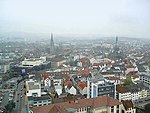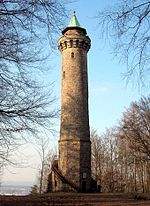Palatinate (region)

The Palatinate (German: Pfalz; Palatine German: Palz), or the Rhenish Palatinate (Rheinpfalz), is a historical region of Germany. Prior to World War II, it was also referred to as Rhenish Bavaria; as a state of the Holy Roman Empire, it was known as the Lower Palatinate (Unterpfalz), which designated only the western part of the Electorate of the Palatinate (Kurfürstentum Pfalz), as opposed to the Upper Palatinate (Oberpfalz). It occupies roughly the southernmost quarter of the German federal state of Rhineland-Palatinate (Rheinland-Pfalz), covering an area of 2,105 square miles (5,450 km2) with about 1.4 million inhabitants. Its residents are known as Palatines (Pfälzer).
Excerpt from the Wikipedia article Palatinate (region) (License: CC BY-SA 3.0, Authors, Images).Palatinate (region)
Wolfsangel, Kaiserslautern Lämmchesberg
Geographical coordinates (GPS) Address Nearby Places Show on map
Geographical coordinates (GPS)
| Latitude | Longitude |
|---|---|
| N 49.433333333333 ° | E 7.7666666666667 ° |
Address
Wolfsangel 23
67663 Kaiserslautern, Lämmchesberg
Rhineland-Palatinate, Germany
Open on Google Maps








